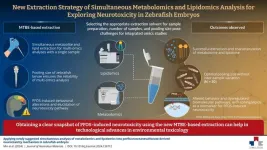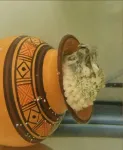SeoulTech researchers propose a novel method to shed light on PFOS-induced neurotoxicity
The strategy simultaneously extracts lipids and metabolites from zebrafish embryos to study perfluorooctanesulfonate (PFOS)-induced neurotoxicity
2025-01-15
(Press-News.org)
The term “omics” refers to the study of entirety of molecular mechanisms that happen inside an organism. With the advent of omics technologies like transcriptomics, proteomics, metabolomics, and lipidomics, our understanding of molecular pathways of toxic environmental pollutants has deepened. But most environmental toxicology studies are still dependent on a single-omics analyses, leading to gaps in our understanding of integrated toxicity pathways of pollutants. Researchers from all over the world have been trying to build reliable biomolecule analyses by designing multi-omics studies from a single biological sample. Although such advances have been reported from various model systems like mammalian cells, Caenorhabditis elegans, etc., toxicology studies on zebrafish are still based on a single-omics analyses using individually prepared biological samples. However, selection of appropriate extraction solvents and pooling size for accurate omics analyses is still a challenge in zebrafish toxicology studies.
To address this gap, a research team led by Professor Ki-Tae Kim has now proposed a novel approach for simultaneous extraction of metabolites and lipids for multi-omics analyses from a single sample using zebrafish embryos. Their study was published in the Journal of Hazardous Materials, made available online on 28 November, 2024.
For this, the researchers used a methyl tert-butyl ether (MTBE)-based extraction strategy using a single biological sample from zebrafish embryos for simultaneous metabolomics and lipidomics analyses. Explaining further, Prof. Kim says, “To increase the applicability of our findings to environmental toxicology, we elucidated the biomolecular mechanisms underlying PFOS-induced neurobehavioral changes and evaluated the analytical performance of the MTBE-based strategy by comparing it with previous findings of PFOS-induced metabolomic dysregulation.”
In their study, Prof. Kim and his team determined the optimal embryo pooling size for the application of MTBE-based extraction. The inter-sample variation was the least when 30 or more larvae were used. They thus suggest using 30 larvae as the optimum pooling size for the simultaneous analysis of metabolomics and lipidomics. Their novel extraction strategy also revealed many lipids and metabolites compared to the conventionally used extraction solvents. Application of the MTBE-based strategy helped record the changes in metabolites and lipids linked to energy metabolism in PFOS-exposed zebrafish larvae.
“The disruption of metabolites and lipids revealed the biomolecular mechanism underlying the alteration of larval behavior by affecting biological processes like energy metabolism including disrupted amino acids and fatty acids metabolism”, says Prof. Kim. Further, the comprehensive profiling of biomolecular dysregulations in this study helped identify sphingolipids as a reliable biomarker of PFOS-induced neurotoxicity. This approach of using a single sample for multi-omics study can be expanded to a variety of biomolecules, leading to the management of toxicity at the biomolecular level. Furthermore, the proposed approach can help in developing a safer and healthier environment in future by facilitating research on the measure of exposure to environmental pollutants.
As is well known, PFOS is one of the most prevalent environmental pollutants commonly found in aquatic ecosystems. Biomonitoring studies have reported high concentrations of it in water, human blood and even human cerebrospinal fluid. Reliable analysis of biomolecules in a single sample is indispensable for multi- and integrative omics, with wide applications in understanding molecular dysregulations by such toxic chemicals. Highlighting the potential of this strategy for expediting such analysis, Prof. Kim says, “The developed method will trigger mechanism-based classification studies of per- and polyfluoroalkyl substances and contribute to the advancement of multi-omics analysis technologies in environmental toxicology.”
***
Reference
DOI: 10.1016/j.jhazmat.2024.136712
About the institute Seoul National University of Science and Technology (SEOULTECH)
Seoul National University of Science and Technology, commonly known as 'SEOULTECH,' is a national university located in Nowon-gu, Seoul, South Korea. Founded in April 1910, around the time of the establishment of the Republic of Korea, SEOULTECH has grown into a large and comprehensive university with a campus size of 504,922 m2. It comprises 10 undergraduate schools, 35 departments, 6 graduate schools, and has an enrollment of approximately 14,595 students.
Website: https://en.seoultech.ac.kr/
About Professor Ki-Tae Kim
Prof. Ki-Tae Kim is a Professor of Environmental engineering at Seoul National University Science and Technology. His group focuses on exploring the adverse effects and toxicity mechanisms of environmental toxicants on ecosystems and humans using zebrafish models. Notably, they have established top-tier research infrastructure for zebrafish models in South Korea, including breeding facilities and behavioral effects measurement systems. Furthermore, we are pioneering research that comprehensively identifies complex mechanisms using various molecular toxicology methods and toxicoinformatics. His work also includes the development of non-experimental toxicity assessment methods and research related to regulatory toxicology, establishing unique research expertise.
END
[Attachments] See images for this press release:

ELSE PRESS RELEASES FROM THIS DATE:
2025-01-15
The Tomosynthesis Mammographic Imaging Screening Trial (TMIST) has reached its enrollment goal of 108,508 women, as announced today by the ECOG-ACRIN Cancer Research Group (ECOG-ACRIN). The study, funded by the National Cancer Institute (NCI), one of the National Institutes of Health, will now proceed with the completion of regularly scheduled mammograms and follow-up on all participants through 2027. Key in this follow-up is the collection of biospecimens and data that will help researchers learn how to personalize breast cancer screening for women.
Participants in TMIST were randomly ...
2025-01-15
WASHINGTON - Women who were cared for by the MedStar Health D.C. Safe Babies Safe Moms program (SBSM) have better outcomes in pregnancy, delivery, and postpartum, according to a study published today in NEJM Catalyst Innovations in Care Delivery. Additionally, the study showed that Black patients cared for by SBSM were also less likely to have low or very low birthweight babies or preterm birth than Black or White patients who received prenatal care elsewhere.
Compared to patients who received prenatal care elsewhere, patients cared for under Safe ...
2025-01-15
Octopus arms move with incredible dexterity, bending, twisting, and curling with nearly infinite degrees of freedom. New research from the University of Chicago revealed that the nervous system circuitry that controls arm movement in octopuses is segmented, giving these extraordinary creatures precise control across all eight arms and hundreds of suckers to explore their environment, grasp objects, and capture prey.
“If you're going to have a nervous system that's controlling such dynamic movement, that's a good way to set it up,” said Clifton Ragsdale, PhD, Professor of Neurobiology at UChicago and senior author ...
2025-01-15
The three-dimensional shape of a protein can be used to resolve deep, ancient evolutionary relationships in the tree of life, according to a study in Nature Communications.
It is the first time researchers use data from protein shapes and combine it with data from genomic sequences to improve the reliability of evolutionary trees, a critical resource used by the scientific community for understanding the history of life, monitor the spread of pathogens or create new treatments for disease.
Crucially, the approach works even with the ...
2025-01-15
PHILADELPHIA, PA (January 15, 2025) - Can memory influence what and how much we eat? A groundbreaking Monell Chemical Senses Center study, which links food memory to overeating, answered that question with a resounding “Yes.” Led by Monell Associate Member Guillaume de Lartigue, PhD, the research team identified, for the first time, the brain’s food-specific memory system and its direct role in overeating and diet-induced obesity.
Published in Nature Metabolism, they describe a specific population of neurons in the mouse brain that encode memories for sugar and fat, profoundly impacting food intake and body ...
2025-01-15
Indigenous students identified inadequate funding as a major barrier to completing post-secondary education according to a new study published in AlterNative: An International Journal of Indigenous Peoples.
The study surveyed Indigenous university students at Algoma University. The students, who identified as either First Nations or Métis, reported that they required multiple sources of funding, including government student loans and personal savings, to afford their post-secondary education. About two-thirds (69%) of students received funding for their education from First Nations sources, including funding from federal programs for Indigenous students.
“This ...
2025-01-15
Hot Jupiters are giant planets initially known to orbit alone close to their star. During their migration towards their star, these planets were thought to accrete or eject any other planets present. However, this paradigm has been overturned by recent observations, and the final blow could come from a new study led by the University of Geneva (UNIGE). A team including the National Centre of Competence in Research (NCCR) PlanetS, the Universities of Bern (UNIBE) and Zurich (UZH) and several foreign universities has just announced the existence of a planetary system, WASP-132, ...
2025-01-15
University of Birmingham venture Dexter has demonstrated the power of its Dexter software platform in a study showing that people whose childhoods featured abuse, neglect or domestic abuse carry a significantly increased risk of developing rheumatoid arthritis or psoriasis in later life.
The starting point for the recently published study was a database of over 16 million Electronic Health Records, from which the Dexter software defined a cohort, one arm that was exposed to childhood maltreatment, and one arm that was not.
The software then checked the records over a 26-year period ...
2025-01-15
The discovery of two new planets beyond our solar system by a team of astronomers from The University of Warwick and the University of Geneva (UNIGE), is challenging scientific understanding of how planetary systems form.
The existence of these two exoplanets - an inner super-Earth and an outer icy giant planet - within the WASP-132 system is overturning accepted paradigms of how ‘hot Jupiter’ planetary systems form and evolve.
Hot Jupiters are planets with masses similar to those of Jupiter, but which orbit closer to their star than Mercury orbits the Sun. There is not enough gas and dust for these giant planets to form ...
2025-01-15
WASHINGTON, D.C. — Weddnesday, Jan. 15, 2025 — Nearly half of Americans (46%) think the country is headed in the wrong direction when it comes to the incoming president’s policies to lower healthcare costs, while 31% say it’s on the right track, according to the latest West Health-Gallup survey released today.
When viewed through a political lens, only Republicans are more positive than negative about the future of healthcare costs under the Trump administration; nearly three-quarters (73%) think the incoming administration’s healthcare policies are headed in the right direction. In contrast, 24% of independents and 3% of Democrats say the same. Democrats ...
LAST 30 PRESS RELEASES:
[Press-News.org] SeoulTech researchers propose a novel method to shed light on PFOS-induced neurotoxicity
The strategy simultaneously extracts lipids and metabolites from zebrafish embryos to study perfluorooctanesulfonate (PFOS)-induced neurotoxicity






